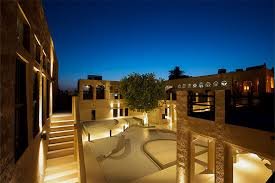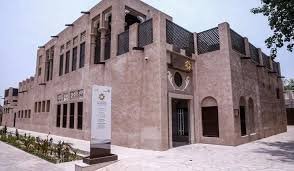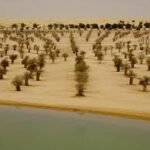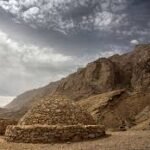Hidden in the shifting sands of the Rub’ al Khali desert lies Saruq Al-Hadid, one of the most enigmatic archaeological sites in the Arabian Peninsula. Discovered accidentally in 2002 by Dubai’s ruler Sheikh Mohammed bin Rashid Al Maktoum during a helicopter flight, this sprawling Iron Age complex has rewritten the history of human settlement in the region. Unlike the glittering skyscrapers of modern Dubai, Saruq Al-Hadid whispers tales of a sophisticated civilization that thrived in the harsh desert environment 3,000 years ago. The site’s name translates to “The Way of Iron,” hinting at its most puzzling feature – evidence of extensive iron smelting in a place with no natural iron ore, suggesting this may have been a sacred industrial hub for ancient metallurgists and traders.
Saruq Al-Hadid: The Accidental Discovery That Changed History
Sheikh Mohammed spotted unusual blackened stones forming strange patterns in the desert from his helicopter, sparking one of the most significant archaeological investigations in the UAE. Initial excavations revealed something extraordinary – not just a temporary camp but a major settlement active from the Iron Age (1,200-500 BCE) through the pre-Islamic period. The site’s location defies conventional wisdom about ancient habitation, situated deep in what is now one of the most inhospitable parts of the desert. Archaeologists were stunned to find evidence that this area was once greener, with underground water sources supporting a substantial population. The discovery challenged previous assumptions that Iron Age peoples avoided this region, suggesting instead a network of sophisticated desert settlements connected by trade routes.
Mysteries of the Snake Cult and Ritual Offerings
Among Saruq Al-Hadid’s most fascinating discoveries are hundreds of snake-shaped artifacts and copper figurines, leading researchers to theorize about an ancient snake cult. Intricately carved serpent motifs appear on weapons, jewelry, and ritual objects, suggesting these creatures held profound spiritual significance. The most startling find was a ceremonial axe featuring a three-dimensional cobra poised to strike, its details so precise that modern herpetologists could identify the exact species. Nearby, archaeologists uncovered a ritual pit filled with thousands of intentionally broken artifacts – weapons, tools, and ornaments all ritually “killed” before burial. This practice, seen in other ancient cultures, suggests ceremonies where valuable objects were sacrificed to unseen forces, possibly connected to metallurgical rituals or desert deities.
The Iron Enigma: Smelting Without Local Resources
Saruq Al-Hadid’s most confounding puzzle is its extensive evidence of iron production despite being located hundreds of kilometers from any known iron ore sources. Excavations have uncovered smelting furnaces, slag heaps, and workshop areas indicating this was a major industrial center. Archaeometallurgists have determined the iron was likely imported as raw ore from distant locations like Oman or even further afield, processed on-site, then traded across the region. This raises profound questions about why ancient peoples would transport heavy ore to this specific desert location rather than smelt it nearer to mines. Some researchers speculate the site held spiritual significance for metalworkers, possibly related to celestial alignments or underground water sources crucial to the smelting process. Others suggest it may have been a neutral trading ground for competing tribes.
Astronomical Alignments and Desert Cosmology
Recent studies reveal Saruq Al-Hadid’s layout appears deliberately aligned with celestial phenomena. Certain structures orient toward sunrise during equinoxes, while artifact concentrations form patterns mirroring constellations visible in the Iron Age night sky. Most intriguing is a circular stone arrangement that precisely marks the summer solstice sunrise when viewed from a central platform. These findings suggest the site may have served as both an industrial center and astronomical observatory, where metallurgical activities were timed with celestial cycles. Ancient Arab cultures closely linked metalworking with cosmic forces, believing the transformation of ore mirrored heavenly transformations. This dual practical and spiritual purpose would explain why such effort was expended to operate in this remote location rather than more convenient sites.

The Gold Artifacts That Shouldn’t Exist
Among thousands of excavated objects, a selection of exquisite gold artifacts has particularly puzzled archaeologists. These include delicate rings, beads, and pendants crafted with techniques more advanced than expected for the period. Chemical analysis revealed the gold contains unusual trace elements not matching known regional sources, suggesting either extremely long-distance trade or lost local gold deposits. One pendant depicts a mythical creature combining features of desert animals in a style never before seen in Arabian art. Even more mysteriously, many gold items show no signs of wear, appearing to have been created solely for ritual purposes before being deliberately buried. These finds hint at a ceremonial aspect to the site that goes beyond practical metallurgy, possibly connected to elite burials or offerings to deities of earth and sky.
The Vanished Civilization and Climate Clues
Evidence suggests Saruq Al-Hadid was abruptly abandoned around 300 BCE, coinciding with a period of dramatic climate change in Arabia. Geological data shows the region experienced rapid desertification during this era, with once-reliable water sources drying up. However, the site’s final layers reveal a puzzling contradiction – while some areas show orderly abandonment with valuable items removed, others contain hastily discarded tools and personal belongings as if people left suddenly. Most haunting is a workshop where a smelting operation was interrupted mid-process, with ore still in crucibles and charcoal half-burned. This frozen moment raises questions about whether environmental change, conflict, or other factors caused the site’s demise. Some archaeologists speculate knowledge of the location was preserved in oral traditions, possibly explaining why Bedouin tribes historically avoided the area long before its modern rediscovery.
Modern Excavations and Ongoing Research of Saruq Al-Hadid
Since 2009, Saruq Al-Hadid has been the focus of intensive study by teams from Dubai Municipality and international universities. The site has yielded over 12,000 artifacts, with only about 10% of the total area excavated so far. Cutting-edge technologies like 3D mapping, drone surveys, and soil chemical analysis are revealing new insights weekly. In 2016, a dedicated museum opened in Dubai’s historic Shindagha district to showcase finds from the site, including interactive displays that let visitors experience ancient smelting techniques. Ongoing research focuses on understanding the settlement’s layout, trade connections, and why this specific location held such importance for over a millennium. Every season brings new surprises – recent digs uncovered evidence of early writing, possibly trade records, that could revolutionize understanding of pre-Islamic Arabian literacy.
Visiting Saruq Al-Hadid Today
While the actual desert site remains closed to general public due to ongoing excavations and its fragile environment, the Saruq Al-Hadid Archaeology Museum offers an immersive experience. Visitors can see meticulously reconstructed workshops, handle replica artifacts, and even try virtual reality simulations of the ancient settlement. Special guided tours occasionally visit the actual site for researchers and VIP guests, who describe an eerie atmosphere as winds whistle through half-excavated stone walls. The surrounding desert still guards many secrets – ground-penetrating radar has revealed possible satellite settlements yet to be investigated. As Dubai continues its rapid modernization, Saruq Al-Hadid stands as a powerful reminder that beneath the glass towers and shopping malls lies a far older story waiting to be told.
Saruq Al-Hadid: The Enduring Riddles of Dubai’s Ancient Metropolis
Saruq Al-Hadid continues to challenge our understanding of ancient Arabia. How did a civilization flourish in what is now extreme desert? Why was iron brought hundreds of kilometers for processing at this specific location? What spiritual beliefs motivated the creation and destruction of such exquisite artifacts? Each answered question reveals new mysteries at this site that blurs the lines between industrial center, astronomical observatory, and ritual complex. As excavations continue, Saruq Al-Hadid promises to rewrite regional history books, proving the deserts surrounding modern Dubai were once home to a sophisticated culture whose achievements echo across three millennia. The sands may have reclaimed this city for centuries, but its secrets are finally emerging to astonish the modern world.
Go to main page


